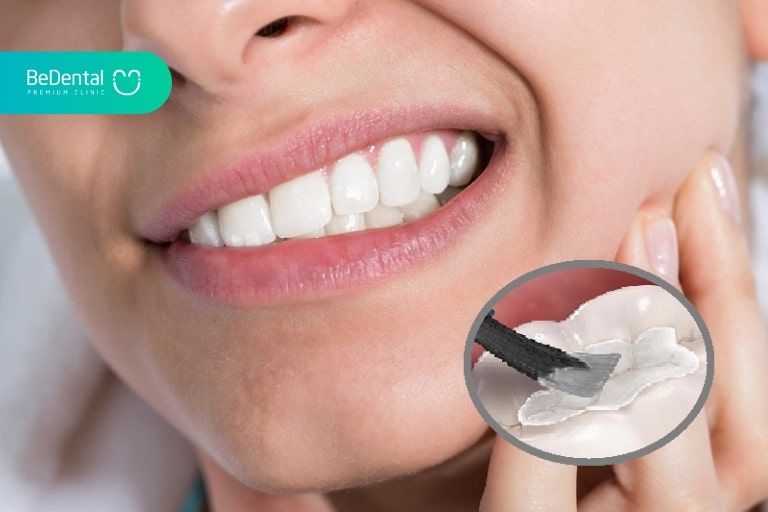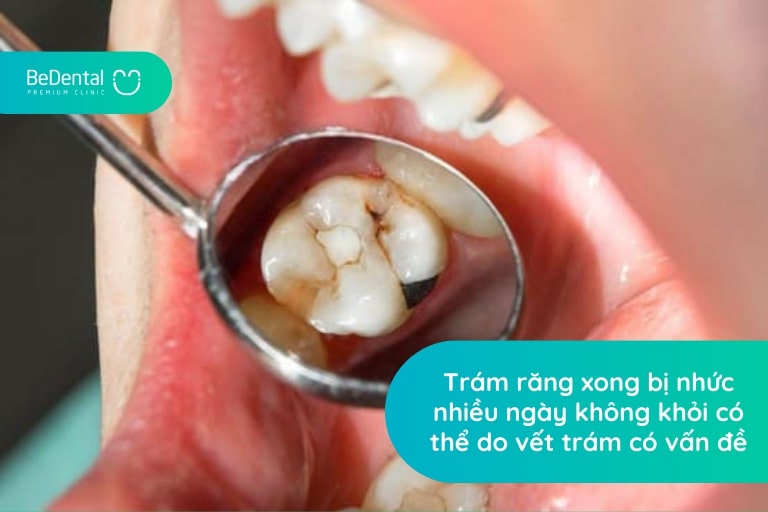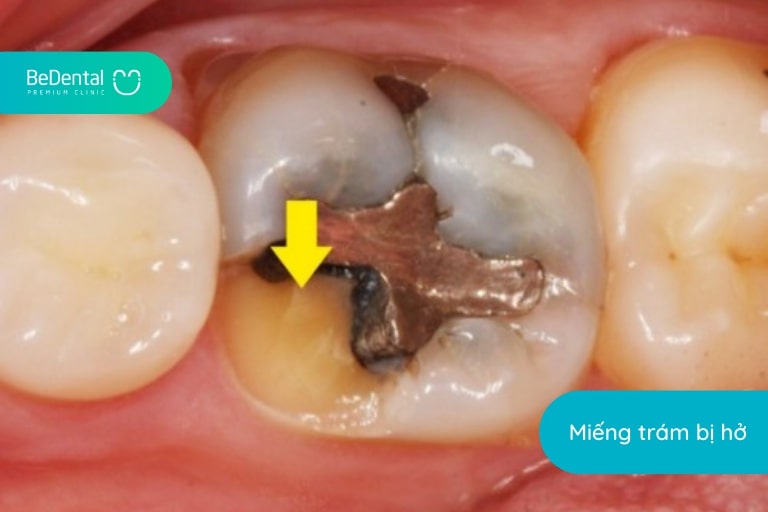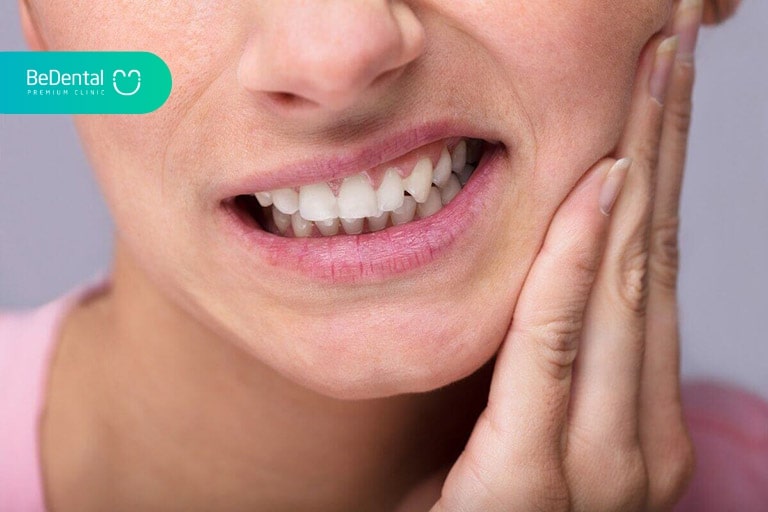Got a toothache after getting a tooth filling? Causes and Treatments for Tooth Filling Pain will be shared by Bedental through the article below, let’s find out!
If teeth are damaged due to cavities or cracks, dental fillings are the optimal choice to help restore aesthetics and limit pain. However, in many cases, tooth filling still causes pain. Not only does it bring worries, but painful chewing teeth fillings over time will greatly affect the eating and living process.
So why does it still hurt after filling a tooth? What is the cause? What is the effective way to treat tooth pain after filling? The answer will be detailed in BeDental’s article below, readers are invited to refer to it.
Distinguishing cases of pain in toothache after getting a tooth filling: what is the cause of concern?
You need to clearly distinguish cases of pain after tooth filling to have appropriate treatment. Because not every case of swelling and pain requires seeing a dentist. And not all cases can treat pain at home.
After getting a tooth filling, I immediately felt pain and sensitivity
The phenomenon of pain and sensitivity after filling a tooth is quite common. Most people encounter this situation because the new filling cannot yet stabilize and adapt to the real tooth.
Besides, external environmental impacts such as air, temperature, humidity, food, etc. will also cause discomfort, swelling and pain at the newly filled tooth location.
Usually this phenomenon only lasts about 3-4 days. That is when the filling has hardened and gradually adapted, you will clearly feel the pain and sensitivity reduce and disappear completely. Therefore, in this case, you do not need to go to the dentist for a check-up.

After a tooth filling, it takes a long time to feel pain
If you notice pain after a tooth filling that doesn’t go away for a long time, that means there’s a problem with the filling. The reason why a tooth filling hurts after filling may be because the newly filled filling has been chipped, cracked or displaced, allowing bacteria to penetrate deep inside.
In addition, there are also some cases of swelling and pain that do not come from the filling but are due to damaged gums, gums or tooth roots. However, whatever the cause, you should see a dentist for examination, determination of the cause and timely treatment.

Causes and treatments of tooth filling pain
In addition to cosmetic restoration, dental fillings also help treat defects and dental diseases that cause swelling and pain such as tooth decay. However, in many cases, after getting a tooth filling, there is pain. So what causes pain after a tooth filling?
There are many reasons why tooth fillings still hurt, including:
Tooth decay has not been thoroughly treated
If you seek cavities filling to treat and prevent cavities from forming, the pain after the filling may be due to the cavity tissue not being completely removed.
Simply put, if the doctor does not do this well, the remaining tooth decay bacteria will continue to multiply, develop and form a new tooth socket. After that, you will clearly feel a dull pain in the area where the cavity was filled.
The tooth pulp shows signs of infection but is not treated
In many cases, the pain after a tooth filling is due to the fact that the tooth pulp was inflamed from the beginning but the doctor did not treat it first and just continued filling the tooth. The consequences are pain, swelling, etc. That also explains the pain after having a deep tooth filling due to inflamed tooth pulp without any intervention or thorough treatment.
More dangerously, if the inflamed pulp is not treated and the doctor still fills the tooth, it can also affect the bone and even cause an extremely dangerous tooth abscess. Therefore, you should find a reputable dental facility with a team of good dentists to know whether your current condition needs root canal treatment or not.
See more: How long does dental filling last? Important considerations after dental filling
Nerves in the mouth are irritated
Sometimes after filling a tooth, pain is caused by damaged and irritated nerves. The root cause is that the dentist’s technique did not handle the filling well. This leads to the filling pressing on the nerve, creating pressure or causing the dentin fluid in the tooth to move.
The body reacts to the filling material
Although all dental filling materials are clinically tested for health safety, with each person’s constitution, the occurrence of an irritating reaction cannot be determined in advance. Therefore, pain after filling a tooth may also be because the customer is allergic to a certain ingredient in the filling material.
However, it cannot be ruled out that you have had dental fillings performed at poor quality dental clinics. Often for profit, less reputable establishments only use substandard dental filling materials, leading to irritation of the filling material, causing sensitivity and pain.
The filling appears to be leaking
Pain after getting a tooth filling could also be due to the filling being exposed. Usually after performing fillings, the doctor will shine a laser light to harden the filling material faster.
However, because of incorrect calculations, when the filling shrinks, gaps will appear. And because of this opening, pain and swelling will appear.
Misaligned bite
The nature of tooth filling is to fill holes and fix defects in teeth. Therefore, maybe in the first few days, you are still not used to biting or chewing at the location where you just filled the filling. More obvious is the sharp pain that appears. However, this condition usually only lasts 1 or 2 days and will go away.

However, there are some cases where symptoms of swelling and pain still appear. The cause is because the filling is too high and too thick compared to the teeth in the oral cavity. When you chew food, it creates pressure and causes your bite to misalign. That is the cause of swelling, pain and sensitivity after the tooth filling is completed.
In this situation, you should see a dentist for examination and adjustment. Because bite misalignment after dental fillings will make you feel extremely uncomfortable during eating and daily activities.
Tooth abscess
In many cases, pain after a tooth filling is caused by a tooth abscess. This is an infection of the dental nerve. Often people with tooth decay or periodontitis, chipped teeth, etc., after dental fillings, this phenomenon is likely to occur when not thoroughly treated.
Symptoms of tooth abscess for you to recognize and see a dentist immediately after filling are:
- Tooth pain is severe.
- Teeth become more sensitive than ever.
- The gum area is red and swollen.
- Mouth has an unpleasant odor.
- Pimple-like swelling on the gums.
- Fever persists and does not subside.
Improper dental care
In addition to the above reasons, tooth pain after filling is also due to improper oral care after filling. For example: after filling your teeth, if you subjectively eat foods that are too hard, contain strong acids or brush your teeth incorrectly,… it will cause the tooth filling to become displaced, damaged, and swelling is unavoidable.
Is it okay to not go to the doctor after having a tooth healed but it still hurts?
As mentioned above, pain after tooth filling is a phenomenon that most people encounter. You need to clearly distinguish between abnormal pain at the tooth filling site and normal pain and swelling.
For normal symptoms of swelling and pain, you don’t need to worry too much. Because they will automatically disappear just a few days later. What you need to pay attention to now is how to take care of your teeth and eat so that the fillings are durable and beautiful, not misaligned.

As for unusual symptoms of swelling and pain after tooth filling, you should see a dentist as soon as possible. Do not let this situation last for many days. Go to a reputable dentist for examination and intervention as soon as possible to prevent other dangerous complications from occurring.
100% effective treatment for tooth pain after filling
There are many ways to overcome swelling and pain after dental fillings. You should clearly determine the cause of the pain so that you can apply the most effective treatment methods.
How to treat tooth filling pain at home
You should be mentally prepared that after getting a tooth filling, you will feel some sensitivity or pain. During the first day, the pain is mild and you can completely fix it yourself at home. Specifically, the pain after filling a tooth will be eliminated when you do:
- Applying a cold compress to the cheek area near the tooth that has just been filled helps reduce pain effectively.
- Use pain relievers as prescribed by your doctor. Usually acetaminophen or ibuprofen.
Note: When you use pain relievers, the swelling still continues. Even if it tends to get worse, seeing a dentist is inevitable. Let the doctor examine more closely, determine the exact cause and treat it thoroughly.
How to treat tooth filling pain at the dentist
In cases where the pain after a tooth filling has not gone away for a long time, you should not continue to apply pain relief methods at home but immediately go to a reputable dentist for examination and treatment. Because if complications after tooth filling are not promptly handled, the consequences will be extremely serious, affecting your entire jaw and health.
The dentist will conduct a comprehensive examination and find the cause. Then, the appropriate post-filling pain treatment method will be selected. Specifically:
If the cause of swelling and pain after tooth filling is due to an open filling or the pulp infection has not been treated, the infection needs to be thoroughly treated. Then, root canal treatment (if necessary) and filling from the beginning.
If the cause is due to poor quality dental filling material, the doctor will replace the filling with a safer material.
If the pain after tooth filling is due to pre-existing dental diseases, the doctor needs to conduct treatment first to completely eliminate the source of the pain. After stabilization, proceed with filling again from the beginning.
Tips for preventing pain after tooth filling
After filling your teeth, to prevent pain after filling, you need to pay attention to how you eat, how to chew, and how to clean your teeth at the newly filled area. As follows:
About chewing and diet after tooth filling
- You should choose foods that are nutritious and soft, easy to swallow, and limit chewing.
- Limit chewing food on the side of the jaw where tooth filling has just been performed.
- Do not eat foods that are too hot or too cold because they can irritate your teeth, causing swelling, pain, or sensitivity.
- Avoid foods that contain a lot of acid because they can erode tooth enamel, making teeth much more sensitive.
- Limit the use of colored foods and drinks to avoid affecting dental fillings.
About oral hygiene
- You should only brush your teeth with a soft-bristled toothbrush and toothpaste for sensitive teeth.
- When brushing your teeth, you should only rub gently, avoid using too much force to damage the filling.
- Get into the habit of using physiological saline to rinse your mouth every day, especially after each meal. Note, you should not mix it yourself but should buy physiological saline that has been mixed at the correct concentration.
- Use dental floss to remove food scraps stuck between teeth instead of using sharp toothpicks.
In addition to paying attention to diet and hygiene, to prevent pain after dental fillings, you should also follow a regular check-up schedule with your dentist.
Hopefully the information in the above article has helped you find answers to the question of why after having a tooth filling it still hurts? What is the cause? What is the effective way to treat tooth pain after filling? To get direct advice from experts, you can contact BeDental, we will support you 24/7.
Reference price list :
Danh mục Unit Giá thành
1.Teeth filling (More detail...)
Baby teeth filling 1 Unit 250.000
~ 10$
Permanent Teeth Filling 1 Unit 500.000
~ 20$
Cosmetic Filling1 Unit 700.000
~ 28$
Sensitive teeth filling1 Unit 500.000
~ 20$
Composite bonding 1 Unit 1.000.000
~ 40$
2.Root Canal Treatment - Anterior by endodontist machine (More detail...)
Root Canal Treatment - Anterior for baby teeth 1 Unit 800.000
~ 31$
Root Canal Treatment - Anterior for Front teeth 1 Unit 1.200.000
~ 47$
Root Canal Treatment - Anterior for Premolar teeth 1 Unit 1.500.000
~ 59$
Root Canal Treatment - Anterior for molar teeth 1 Unit 2.000.000
~ 79$
3.Root Canal reTreatment - Anterior by endodontist machine
Root Canal Treatment - Anterior for Front teeth by endodontist machine 1 Unit 1.500.000
~ 59$
Anterior for Premolar teeth by endodontist machine 1 Unit 1.800.000
~ 71$
Anterior for molar teeth by endodontist machine 1 Unit 2.300.000
~ 90$
4 Vecniflour dental care (More detail...)
Vecniflour dental care for child 1 Unit 500.000
~ 20$
See more: 5 causes of porcelain tooth sensitivity?
See more: 10 ways to get white seeds in the throat
BEDENTAL - TOP STANDARD DENTISTRY SYSTEM
In HANOI
Address 1: 7B Thi Sach St, Ngo Thi Nham, Hai Ba Trung Dist, Ha Noi. - 0934.61.9090
Address 2: No 129 Hoang Ngan, Yen Hoa, Cau Giay Dist, Ha Noi. - 0934.61.9090
In HO CHI MINH
Address 1: 53 -55 -57 Pho Duc Chinh St, Nguyen Thai Binh, Dist. 1, Ho Chi Minh. - 0766.00.8080
Working: 9am - 8pm everyday
Website: https://bedental.vn/en/




